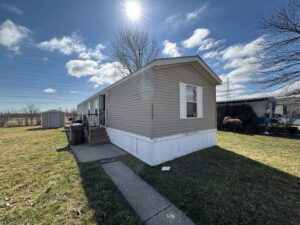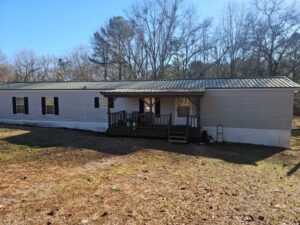Did you know that the average cost of a singlewide mobile home in the United States is around $60,000? Understanding the expenses involved in purchasing and maintaining a singlewide can help you make informed decisions about this type of housing. From initial purchase price to ongoing maintenance costs, uncovering the true cost of a singlewide is crucial for budget-conscious individuals looking for affordable housing solutions.

Single-Wide vs Double-Wide Overview
Size Difference
Single-wide homes are typically smaller, ranging from 600 to 1,300 square feet, while double-wide homes offer more space, around 1,100 to 2,400 square feet. The layout of a single-wide is long and narrow, suitable for smaller families or individuals. In contrast, double-wides have a wider layout, providing more room for larger families.
Cost Variations
When it comes to the cost of a singlewide versus a double-wide home, single-wides are more budget-friendly upfront. The price range for a single-wide can vary depending on the zone and lot size, but they generally cost less than double-wides. However, it’s worth noting that over time, maintenance costs for single-wides might be higher due to their smaller size and construction materials.
Pros and Cons
Pros of Single-Wide Homes:
Lower initial cost
Easier maintenance due to smaller size
Cons of Single-Wide Homes:
Limited space for growing families
Resale value may not increase significantly over time
Pros of Double-Wide Homes:
More space for comfortable living
Higher resale value compared to single-wides
Cons of Double-Wide Homes:
Higher initial cost
More challenging maintenance due to larger size

Key Cost Factors in Manufactured Homes
Size Impact
The size of a manufactured home significantly influences its cost. Larger single-wide homes tend to be more expensive due to the increased materials required for construction.
Material Selection
Materials play a crucial role in determining the cost of a manufactured home. Opting for high-quality materials can raise the overall price, while choosing more affordable options can help reduce expenses.
Location Consideration
The location where the manufactured home will be placed is another key factor affecting costs. Areas with high demand or premium neighborhoods can drive up prices compared to more rural or less sought-after locations.
Long-Term Maintenance
Considering long-term maintenance costs is essential when evaluating the total expenses of a manufactured home. Investing in durable materials and regular upkeep can contribute to lower maintenance costs over time, saving homeowners money in the long run.
Understanding Transport and Setup Expenses
Logistical Challenges
Transporting a singlewide manufactured home involves coordinating with specialized moving companies equipped to handle such structures. The delivery process requires careful planning due to the size and weight of these homes.
Navigating narrow roads, sharp turns, and low-hanging obstacles can pose significant challenges during transport. These obstacles may require additional equipment or alternative routes, increasing the overall setup costs.
Cost Breakdown
The expenses for transporting a singlewide manufactured home typically include delivery, permits, pilot cars, and utility disconnections. Setting up the home involves foundation construction, leveling, and utility reconnections.
To minimize transport and setup expenses, homeowners can plan ahead by obtaining accurate measurements of the home and final location. Properly clearing the path for transportation and ensuring a suitable foundation at the destination can help reduce unforeseen costs.

Customization and Add-Ons Pricing
Available Options
Manufactured homes offer a range of customization options to suit individual preferences. From flooring materials to kitchen appliances, these features can be tailored to meet specific needs. The cost of these customizations varies based on the complexity and quality of the upgrades.
Impact on Price
Adding customizations and add-ons can significantly impact the overall price of a singlewide home. While basic models come at a lower cost, incorporating high-end features can quickly escalate the total expense. It’s essential for buyers to carefully consider their priorities and budget constraints when selecting upgrades.
Balancing Desires with Budget
To ensure affordability, it’s crucial to strike a balance between desired customizations and financial limitations. Prioritize essential upgrades that add value and functionality to the home while being mindful of unnecessary expenses. Researching different features and their associated costs can help buyers make informed decisions without overspending.

Site Preparation Financial Overview
Budgeting
When preparing the site for a singlewide manufactured home, budgeting is crucial. Consider costs for site leveling, foundation installation, and utility connections. Ensure your budget covers all necessary expenses.
Financing Options
Explore various financing options to cover site preparation costs. Look into loans specifically designed for home sites and construction. Compare interest rates and terms to find the most suitable option.
Cost Breakdown
Understand the breakdown of costs involved in site preparation. This includes expenses for land clearing, foundation materials, and utility hook-ups. Be aware of any additional fees that may arise during the process.
Sectional Considerations
Singlewide homes are typically delivered in sections and assembled on-site. Factor in the costs associated with transporting each section to the location and connecting them securely.
Quality vs. Cost
While aiming for cost-effective site preparation, prioritize quality to ensure the longevity of your home. Opt for a sturdy permanent foundation over temporary solutions to avoid future maintenance issues.

Comparing Single-Wide and Double-Wide Costs
Initial Costs
Single-wide homes typically cost less than double-wide homes due to their smaller size and simpler construction. The initial expense for a single-wide is generally more budget-friendly, making it an attractive option for those looking to save money upfront.
On the other hand, double-wide homes come with a higher initial price tag compared to single-wide homes. The larger size and additional features contribute to the increased cost of double-wide homes. While they offer more space and amenities, this comes at a premium price.
Long-Term Expenses
Single-wide homes often have lower long-term expenses when it comes to maintenance, utilities, and repairs. Their compact size means lower utility bills and reduced maintenance costs over time. This can result in savings for homeowners in the long run.
In contrast, double-wide homes may incur higher long-term expenses due to their larger size and increased maintenance needs. Utility costs can be higher for double-wides, along with potentially more frequent repairs and upkeep requirements. Homeowners should consider these factors when evaluating the overall cost of ownership.
Additional Ownership Costs
Insurance
Purchasing insurance for a single-wide manufactured home is crucial to protect your investment. Insurance premiums can vary based on factors like the home’s age, location, and coverage level.
Property Taxes
Property taxes are another significant ongoing expense for single-wide homeowners. These taxes are typically based on the assessed value of the property and can fluctuate annually.
Maintenance Fees
Regular maintenance is essential to keep your single-wide home in top condition. Budget for maintenance fees such as repairs, landscaping, and general upkeep to avoid unexpected costs.
When considering the total cost of ownership for a single-wide manufactured home, it’s vital to factor in these additional expenses. Proper budgeting for insurance, property taxes, and maintenance can help you manage your finances effectively. By planning ahead and setting aside funds for these recurring costs, you can ensure long-term financial stability and enjoy your home without financial stress.
Making an Informed Purchasing Decision
Factors to Consider
When buyers are looking at the cost of a singlewide home, several key aspects should be evaluated. Firstly, low prices are attractive, but it’s crucial to also assess the energy efficiency of the property. Understanding various options available in terms of flooring, fixtures, and layout is essential.
Budget and Location Evaluation
One of the primary requirements for potential buyers is to establish a clear budget. This involves not just the upfront cost of purchase, but also ongoing expenses like utilities and maintenance. Considering the location within a desired community or area is vital for long-term satisfaction.
Research and Professional Advice
To make an informed decision, it’s imperative for families to delve into detailed data about different models and builders. Visiting a factory where these homes are constructed can provide valuable insights into the quality of workmanship. Seeking advice from real estate professionals can also help navigate the complexities of acquiring a manufactured home.
Closing Thoughts
In weighing the costs of a single-wide mobile home, you’ve delved into crucial factors that impact your budget. Understanding the nuances between single-wide and double-wide homes, along with additional ownership expenses, equips you to make an informed decision about your investment. By considering customization options, site preparation needs, and transport costs, you are better prepared to navigate the financial landscape of manufactured home ownership.
As you move forward in your purchasing journey, remember that knowledge is power. Take advantage of the insights gained here to confidently assess the total cost of owning a single-wide mobile home. Your informed approach will not only save you money but also ensure that your new home meets your needs without breaking the bank.
Frequently Asked Questions
What are the main differences between single-wide and double-wide manufactured homes?
Single-wide homes are typically narrower and more affordable, while double-wide homes offer more space and resemble traditional site-built homes. Double-wides often have higher resale values due to their larger size and amenities.
How do customization and add-ons affect the cost of a single-wide home?
Customization options like upgraded flooring, fixtures, and appliances can increase the overall cost of a single-wide home. Add-ons such as porches, decks, or carports also contribute to the final price but allow for personalization and enhanced functionality.
What factors contribute to the total cost of owning a single-wide manufactured home?
Apart from the initial purchase price, ongoing expenses like utility bills, maintenance costs, insurance premiums, property taxes, and any financing charges add up. Understanding these additional ownership costs is crucial for budgeting effectively over the long term.
Is site preparation an important consideration when purchasing a single-wide home?
Yes, preparing the site for your single-wide home involves costs for clearing land, installing utilities like water and electricity connections, foundation setup or skirting installation. Proper site preparation ensures a safe and stable environment for your manufactured home.
How can I make an informed decision when buying a single-wide manufactured home?
Research thoroughly on key cost factors, compare pricing between different manufacturers or dealerships, understand ownership expenses beyond the initial purchase, factor in customization needs, evaluate site preparation requirements – all these steps will help you make a well-informed decision that aligns with your budget and preferences.
You may be interested in these articles as well:
Peppermint Oil Cats: Repellent Solutions

